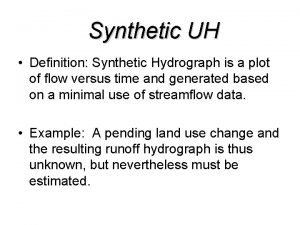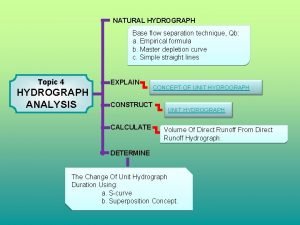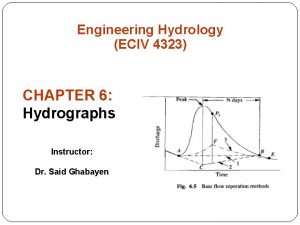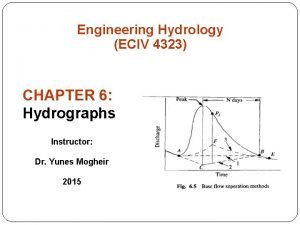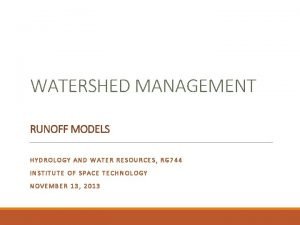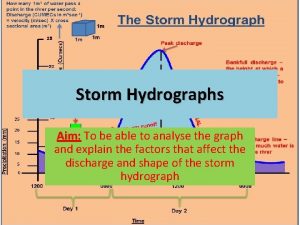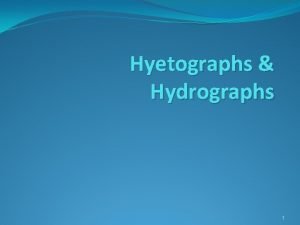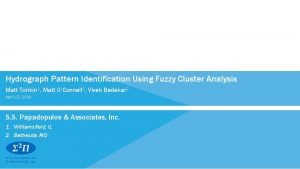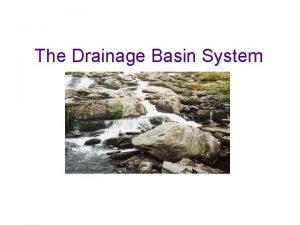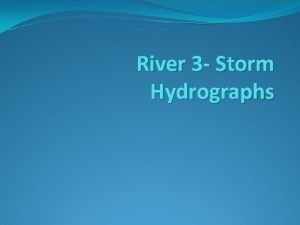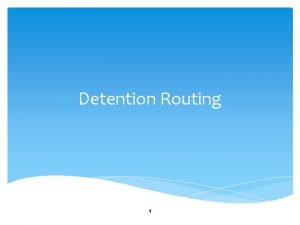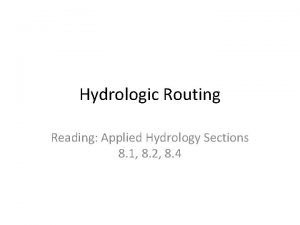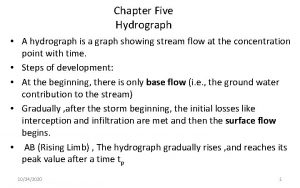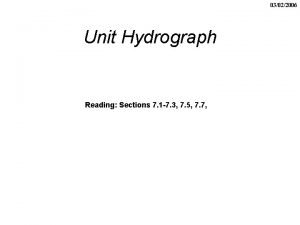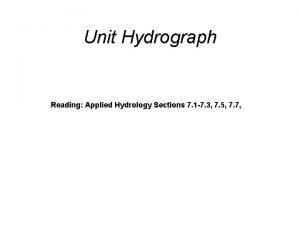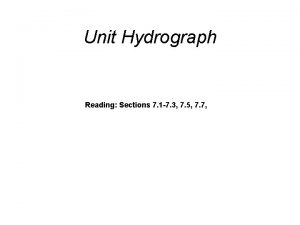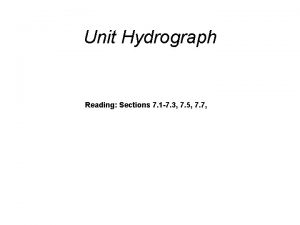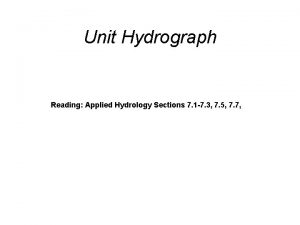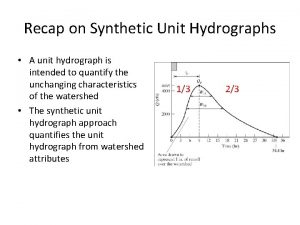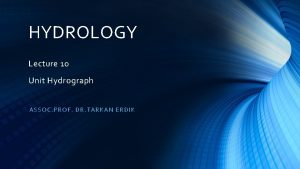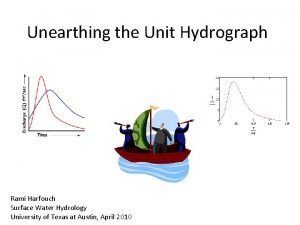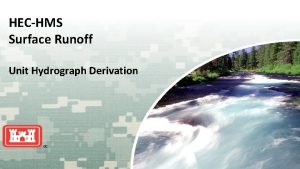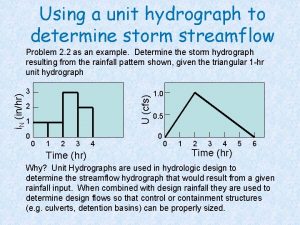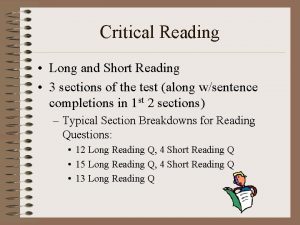Unit Hydrograph Reading Sections 7 1 7 3


















- Slides: 18

Unit Hydrograph Reading: Sections 7. 1 -7. 3, 7. 5, 7. 7,

Hydrologic Analysis Change in storage w. r. t. time = inflow - outflow In the case of a linear reservoir, S = k. Q Transfer function for a linear system (S = k. Q).

Proportionality and superposition • Linear system (k is constant in S = k. Q) – Proportionality • If I 1 Q 1 then C*I 2 C*Q 2 – Superposition • If I 1 Q 1 and I 2 Q 2, then I 1 +I 2 Q 1 + Q 2

Impulse response function Impulse input: an input applied instantaneously (spike) at time t and zero everywhere else An unit impulse at t produces as unit impulse response function u(t-t) Principle of proportionality and superposition

Convolution integral • For an unit impulse, the response of the system is given by the unit impulse response function u(t-t) • An impulse of 3 units produces the 3 u(t-t) • If I(t) is the precipitation intensity occurring for a time period of dt, the response of the system (direct runoff) is I(t)u(t-t)dt • The complete response due to the input function I(t) is given by convolution integral • Response of a linear system is the sum (convolution) of the responses to inputs that have happened in the past.

Step and pulse inputs • A unit step input is an input that goes from 0 to 1 at time 0 and continues indefinitely thereafter • A unit pulse is an input of unit amount occurring in duration Dt and 0 elsewhere. Precipitation is a series of pulse inputs!

Unit Hydrograph Theory • Direct runoff hydrograph resulting from a unit depth of excess rainfall occurring uniformly on a watershed at a constant rate for a specified duration. • Unit pulse response function of a linear hydrologic system • Can be used to derive runoff from any excess rainfall on the watershed.

Unit hydrograph assumptions • Assumptions – Excess rainfall has constant intensity during duration – Excess rainfall is uniformly distributed on watershed – Base time of runoff is constant – Ordinates of unit hydrograph are proportional to total runoff (linearity) – Unit hydrograph represents all characteristics of watershed (lumped parameter) and is time invariant (stationarity)

Discrete Convolution Continuous Discrete Q is flow, P is precipitation and U is unit hydrograph M is the number of precipitation pulses, n is the number of flow rate intervals The unit hydrograph has N-M+1 pulses

Application of convolution to the output from a linear system

Time – Area Relationship Excess Rainfall Area Isochrone of Equal time to outlet 0 Time, t 5 10 Time, t 15 20

Application of UH • Once a UH is derived, it can be used/applied to find direct runoff and stream flow hydrograph from other storm events. Given: Ex. 7. 5. 1 P 1 = 2 in, P 2 = 3 in and P 3 = 1 in, baseflow = 500 cfs and watershed area is 7. 03 mi 2. Given the Unit Hydrograph below, determine the streamflow hydrograph

7. 5. 1 solution (cont’d) See another example at: http: //www. egr. msu. edu/~northco 2/BE 481/UHD. htm

Gauged and ungauged watersheds • Gauged watersheds – Watersheds where data on precipitation, streamflow, and other variables are available • Ungauged watersheds – Watersheds with no data on precipitation, streamflow and other variables.

Need for synthetic UH • UH is applicable only for gauged watershed and for the point on the stream where data are measured • For other locations on the stream in the same watershed or for nearby (ungauged) watersheds, synthetic procedures are used.

Synthetic UH • Synthetic hydrographs are derived by – Relating hydrograph characteristics such as peak flow, base time etc. with watershed characteristics such as area and time of concentration. – Using dimensionless unit hydrograph – Based on watershed storage

SCS dimensionless hydrograph • Synthetic UH in which the discharge is expressed by the ratio of q to qp and time by the ratio of t to Tp • If peak discharge and lag time are known, UH can be estimated. Tc: time of concentration C = 2. 08 (483. 4 in English system) A: drainage area in km 2 (mi 2)

Ex. 7. 7. 3 • Construct a 10 -min SCS UH. A = 3. 0 km 2 and Tc = 1. 25 h 0. 833 h q Multiply y-axis of SCS hydrograph by qp and x-axis by Tp to get the required UH, or construct a triangular UH 7. 49 m 3/s. cm 2. 22 h t
 Unit hydrograph
Unit hydrograph Unit hydrograph convolution
Unit hydrograph convolution Unit hydrograph superposition method
Unit hydrograph superposition method The basic assumptions of the unit hydrograph theory are
The basic assumptions of the unit hydrograph theory are The basic assumptions of the unit-hydrograph theory are
The basic assumptions of the unit-hydrograph theory are While reading activities
While reading activities Runoff volume
Runoff volume How to read a hydrograph
How to read a hydrograph Flashy and flat hydrograph
Flashy and flat hydrograph Storm hydrograph
Storm hydrograph Ce424
Ce424 Hyetograph
Hyetograph Hair hydrograph
Hair hydrograph Passaic river hydrograph
Passaic river hydrograph Hydrograph
Hydrograph Storm hydrograph definition
Storm hydrograph definition Outflow hydrograph
Outflow hydrograph Applied hydrology
Applied hydrology Unit 10, unit 10 review tests, unit 10 general test
Unit 10, unit 10 review tests, unit 10 general test
